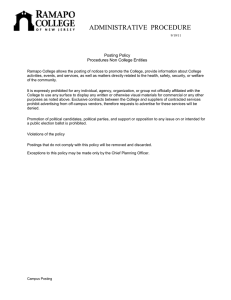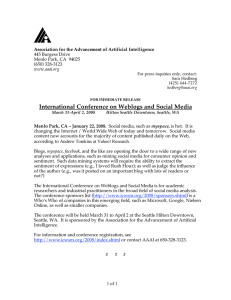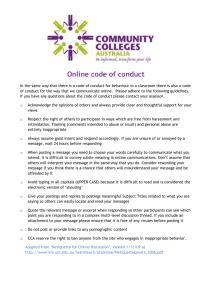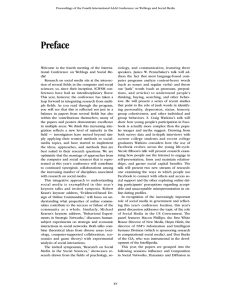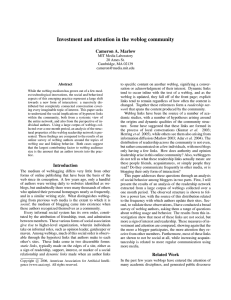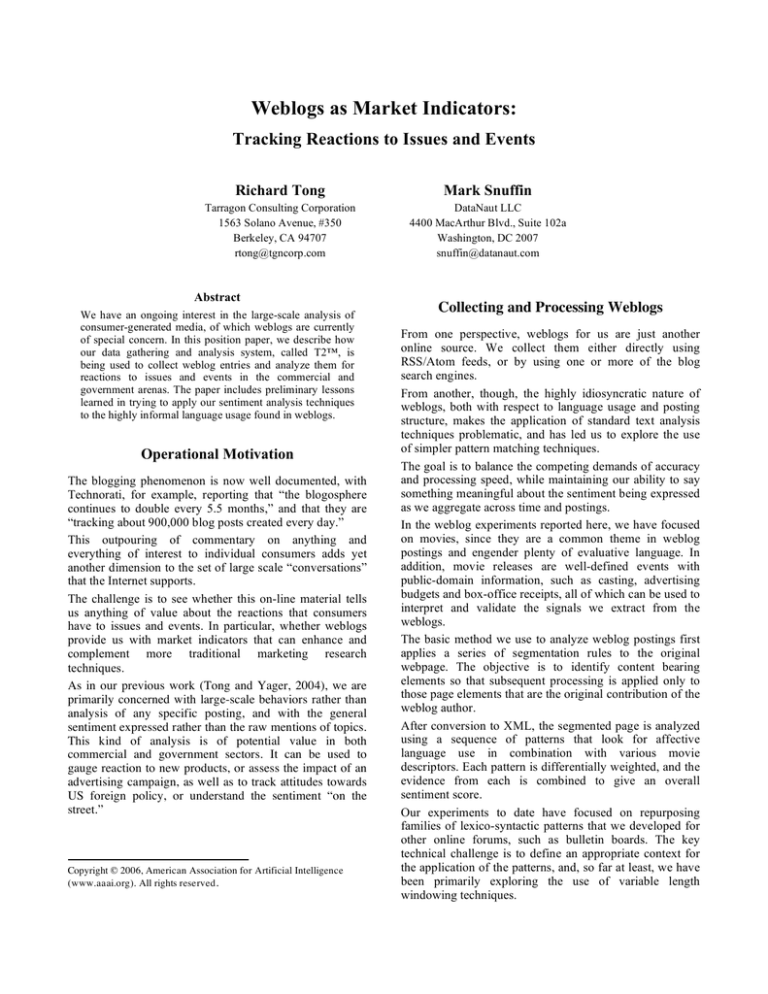
Weblogs as Market Indicators:
Tracking Reactions to Issues and Events
Richard Tong
Mark Snuffin
Tarragon Consulting Corporation
1563 Solano Avenue, #350
Berkeley, CA 94707
rtong@tgncorp.com
DataNaut LLC
4400 MacArthur Blvd., Suite 102a
Washington, DC 2007
snuffin@datanaut.com
Abstract
We have an ongoing interest in the large-scale analysis of
consumer-generated media, of which weblogs are currently
of special concern. In this position paper, we describe how
our data gathering and analysis system, called T2™, is
being used to collect weblog entries and analyze them for
reactions to issues and events in the commercial and
government arenas. The paper includes preliminary lessons
learned in trying to apply our sentiment analysis techniques
to the highly informal language usage found in weblogs.
Operational Motivation
The blogging phenomenon is now well documented, with
Technorati, for example, reporting that “the blogosphere
continues to double every 5.5 months,” and that they are
“tracking about 900,000 blog posts created every day.”
This outpouring of commentary on anything and
everything of interest to individual consumers adds yet
another dimension to the set of large scale “conversations”
that the Internet supports.
The challenge is to see whether this on-line material tells
us anything of value about the reactions that consumers
have to issues and events. In particular, whether weblogs
provide us with market indicators that can enhance and
complement more traditional marketing research
techniques.
As in our previous work (Tong and Yager, 2004), we are
primarily concerned with large-scale behaviors rather than
analysis of any specific posting, and with the general
sentiment expressed rather than the raw mentions of topics.
This kind of analysis is of potential value in both
commercial and government sectors. It can be used to
gauge reaction to new products, or assess the impact of an
advertising campaign, as well as to track attitudes towards
US foreign policy, or understand the sentiment “on the
street.”
Copyright © 2006, American Association for Artificial Intelligence
(www.aaai.org). All rights reserved .
Collecting and Processing Weblogs
From one perspective, weblogs for us are just another
online source. We collect them either directly using
RSS/Atom feeds, or by using one or more of the blog
search engines.
From another, though, the highly idiosyncratic nature of
weblogs, both with respect to language usage and posting
structure, makes the application of standard text analysis
techniques problematic, and has led us to explore the use
of simpler pattern matching techniques.
The goal is to balance the competing demands of accuracy
and processing speed, while maintaining our ability to say
something meaningful about the sentiment being expressed
as we aggregate across time and postings.
In the weblog experiments reported here, we have focused
on movies, since they are a common theme in weblog
postings and engender plenty of evaluative language. In
addition, movie releases are well-defined events with
public-domain information, such as casting, advertising
budgets and box-office receipts, all of which can be used to
interpret and validate the signals we extract from the
weblogs.
The basic method we use to analyze weblog postings first
applies a series of segmentation rules to the original
webpage. The objective is to identify content bearing
elements so that subsequent processing is applied only to
those page elements that are the original contribution of the
weblog author.
After conversion to XML, the segmented page is analyzed
using a sequence of patterns that look for affective
language use in combination with various movie
descriptors. Each pattern is differentially weighted, and the
evidence from each is combined to give an overall
sentiment score.
Our experiments to date have focused on repurposing
families of lexico-syntactic patterns that we developed for
other online forums, such as bulletin boards. The key
technical challenge is to define an appropriate context for
the application of the patterns, and, so far at least, we have
been primarily exploring the use of variable length
windowing techniques.
The figure below shows example sentiment timelines for
the movie Hustle and Flow, which was released on July 22,
2005. The upper curve (colored black in the original)
shows the positive sentiment. The lower curve (colored red
in the original) shows the negative sentiment.
Hustle and Flow
Opening Weekeend July 24
5
4.5
4
Positive Sentiment
Sentiment Score
3.5
Negative Sentiment
3
2.5
2
1.5
1
0.5
9/
7/
05
9/
14
/0
5
9/
21
/0
5
9/
28
/0
5
8/
3/
05
8/
10
/0
5
8/
17
/0
5
8/
24
/0
5
8/
31
/0
5
7/
6/
05
7/
13
/0
5
7/
20
/0
5
7/
27
/0
5
6/
8/
05
6/
15
/0
5
6/
22
/0
5
6/
29
/0
5
6/
1/
05
0
We see that these timelines follow a familiar pattern;
increasing chatter before the opening, a spike at the
opening weekend itself, then a decreasing trend as fewer
and fewer theaters show the movie.
The sentiment scale is based on the idea that both positive
and negative sentiment range over the unit interval, and
that a given posting thus contributes at most 1.0 to the
sentiment scores. On a daily basis, the overall sentiment
score is just the sum of the sentiment scores for postings on
that day.
Weblog Analysis
In this current project, we looked at weblog postings on a
selection of movies released in 2005, and restricted our
analysis to those in English.
A review of the corpus we collected suggests that, for this
domain at least, we can divide postings into two main
groups. Those that are substantive movie reviews, and
those that mention the movie “in passing.”
An example of a posting in the first group is from blogspot
.com on July 30, 2005 in which the blogger is writing a
review of the move Hustle and Flow. The posting contains
usage like “the best movie that I have seen this year,” “the
soundtrack is tight as hell,” and “I recommend this movie
highly.” Such postings look just like material from other
sources we have worked with, and are thus amenable to the
application of similar analytic techniques.
An example of a posting in the second group is from
blogsome.com on August 9, 2005 that starts:
No seriously, holler at ya girls…“whoop that trick” (a
la Hustle and Flow) if u have to b/c I give up.
where the movie is used a cultural reference and in a
highly informal linguistic context.
Another example from the second group is more typical. In
a posting from livejounal.com on August 29, 2005 we see:
In Chicago, my mom dragged me to Hustle and Flow.
In Boston, it was 40 Year Old Virgin. Entertaining the
second time, but not as much so at all. Seth Rogan is
hottttt.
where the reference simply marks one activity among a
series of activities that this posting describes, but is not
really the point of the posting.
Our approach to analysis is first to locate postings that
contain a mention of the target (in this example the movie
Hustle and Flow). For each of these postings, we generate
a series of text windows of different widths centered on the
target mention. Then in these windows we look for both
domain specific and evaluative language usage. That is, we
look for language that is specific to movies, such as the
names of actors and directors, and various aspects of movie
making, such as the soundtrack and the editing. We also
look for affective language, both with reference to personal
state, as well as to movie characteristics.
We have been experimenting with windows of size 20,
100, and 250 words, and using lexically-based patterns that
we originally developed for other online movie forums.
The strategy is to make multiple passes to locate
collocations of patterns, and then differentially combine
the evidence we find into an overall sentiment score.
Given the often irregular use of punctuation and markup in
weblog postings, we make no attempt to identify anything
that looks like a sentence or paragraph boundary, and rely
entirely on these proximity surrogates to define regions of
interest.
To date, we have not experimented on the weblog data
with any NLP techniques, such as shallow parsers. Our
experience with other informal online sources is that the
value we get from the use of more sophisticates language
analysis techniques depends critically on the insights we
are trying to gain from the data.
Since our current focus is on large-scale behaviors and the
market signals they can give us, we are working on the
assumption that the kinds of trend analysis we are
developing are relatively insensitive to point failures of
language interpretation. Future experiments will attempt to
test this conjecture.
T2™ Infrastructure
The T2™ infrastructure is a scalable, configurable content
acquisition system that is designed to collect and manage
large amounts of open source material, such as weblogs, as
well as that found on websites, message boards, mailing
lists, and other Internet forums. The figure below gives an
overview of the architecture.
people are posting in an easily accessible public forum
obviously presents us with a unique opportunity. At the
same time, however, we need to focus on what “signal” we
want to extract from the background “noise.”
A movie studio trying to assess the impact of pre-release
advertising, has a different goal from a consumer product
company trying to get insight into the market’s reaction to
a new product feature. In turn, these goals are distinct from
that of a political organization that is trying to build
support for a policy issue.
In all these scenarios, what we currently lack is any notion
of a benchmark against which to calibrate the responses we
see. What we want to know is whether the extracted signal
correlates with the number of tickets sold, or gives us
insight into potential customer support issues, or can
predict the outcome of an election.
A critical challenge for researchers interested in the
computational analysis of weblogs, and, by extension,
other consumer-generated media, is to understand the
motivations behind personal expression on the Internet,
and how this relates to actions in the real world. Processing
the content of postings is certainly part of the puzzle, but
we need to do the interpretation in the appropriate social
and cultural context if we are to create tangible value.
References
T2™ is a totally automated approach to data gathering and
analysis that combines smart web crawlers, data
warehousing technology, fully configurable data
processing and analysis workflows, and interactive report
generation.
In the base configuration (shown shaded in the figure) the
T2™ infrastructure includes a set of standard “Analysis
Services,” including a generic query language and search
capability, families of meta-data extractors and taggers,
content analyzers that use fuzzy regular expression
techniques, and document de-duplication algorithms.
Specialized modules, such as advanced sentiment tracking
algorithms, and time-series analysis tools can be inserted
into the processing architecture as needed to meet specific
application requirements.
Commentary
Blogging is a phenomenon that certainly deserves our
attention. On one level it represents a perfect expression of
the power of the Internet to democratize the publication
and dissemination of commentary and opinions. On
another, it provides us with a massive amount of naturally
occurring text that presents novel challenges to our existing
arsenal of language processing tools and technologies.
From a business perspective, though, we need to ask what
it is about weblogs that is of value to us. The fact that
Technorati Weblog. State of the Blogosphere, August
2005, Part 1: Blog Growth. Posted by Dave Sifry on
August 02, 2005.
http://www.technorati.com/weblog/2005/08/34.html
Technorati Weblog. State of the Blogosphere, August
2005, Part 2: Posting Volume. Posted by Dave Sifry on
August 02, 2005.
http://www.technorati.com/weblog/2005/08/35.html
Tong, R. M., and Yager, R. R. 2004. Characterizing
Attitudinal Behaviors in On-Line Open Sources. In AAAI
Spring Symposium on Exploring Attitude and Affect in
Text, AAAI Technical Report SS-04-07, Qu, Y.;
Shanahan, J.; and Wiebe, J. eds.


